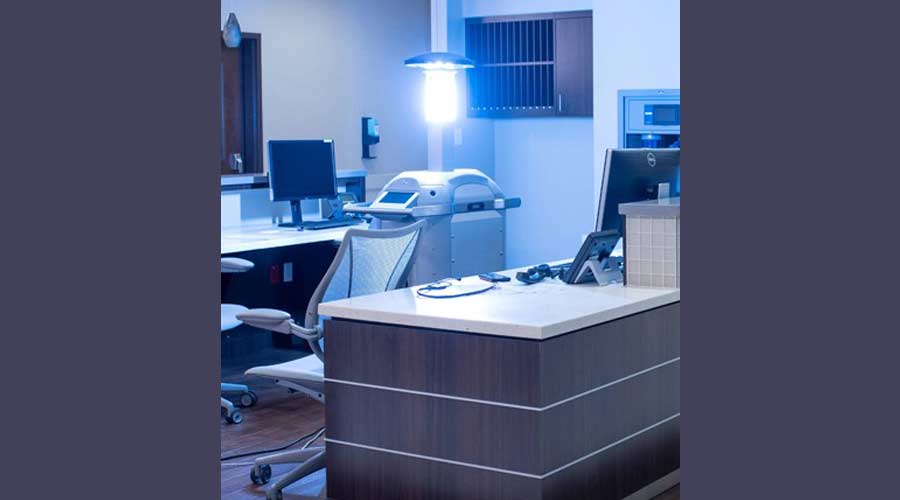
Harmful pathogens remain on commonly touched surfaces, even after the best liquid chemical cleaning efforts. As healthcare facilities battle viruses, bacteria and spores that can lurk on high-touch surfaces, proactive hospitals have invested in powerful UV-C disinfection technology to destroy pathogens missed during the manual room cleaning process. In a milestone achievement, Xenex LightStrike Germ-Zapping Robot customers recently completed 35 million disinfection cycles.
The LightStrike robot utilizes intense bursts of pulsed xenon ultraviolet (UV) light to quickly deactivate viruses, bacteria and spores on surfaces and is effective against even the most dangerous superbugs and multi-drug resistant organisms (MDRO), including methicillin-resistant Staphylococcus aureus (MRSA), Clostridioides difficile (C. diff), VRE, and SARS-CoV-2 (the virus that causes COVID-19).
LightStrike robots, deployed by more than 1,000 healthcare facilities, use IoT (Internet of Things) technology to report utilization to a cloud-based portal. Hospital officials track who is using the robot and where it’s being operated, providing the hospital with rich performance information, including how many disinfection cycles have been performed. More than 45 peer-reviewed, published studies in scientific journals validate the efficacy of the LightStrike disinfection technology.
United Hospital Center (UHC), a WVU Medicine facility, is an innovator in the use of UV-C disinfection technology. The hospital’s investment in Xenex LightStrike Germ-Zapping Robots, led by Vice President of Quality and Chairman of Infection Prevention Dr. Mark Povroznik, has been instrumental in helping the hospital achieve its disinfection goals. Its Environmental Services (EVS) team was recently recognized for leading the world in the number of rooms disinfected by its LightStrike Germ-Zapping Robots in 2021. UHC utilizes seven robots, which are strategically placed throughout the hospital to timely support disinfection of the OR suites, Emergency Department, patient rooms, cath lab, restrooms, pharmacy, ICUs, pediatrics, and other areas as needed.
Use of the LightStrike technology enhances the hospital’s already thorough processes for cleaning rooms and destroying the pathogens that can transmit from surfaces to people. In fact, the LightStrike robots are considered part of the hospital’s cleaning team. First, the room has to be cleaned and all visible dirt/fluids removed, trash emptied, linens removed – a normal cleaning. Then once the room is visually clean, the robot is brought in by an EVS team member to destroy microorganisms missed during the manual cleaning process.
The robots, which work in five-minute cycles, do not require warm-up or cool-down time and don’t harm surfaces or expensive hospital equipment like mercury lamp UV devices.
HonorHealth was one of the first U.S. health systems to deploy these robots systemwide and now has more than 30 germ-zapping robots being used throughout its six hospitals and ambulatory care facilities. Purchased with funds generously provided by the health system’s foundation, the robot was first used in HonorHealth’s unit for patients with blood cancers at Scottsdale Shea Medical Center. After the success of the initial program, the HonorHealth Foundation raised additional philanthropic funding to expand the robots’ use throughout the network. HonorHealth Scottsdale Osborn Medical Center was recently recognized for “Excellence in Disinfection” as a result of its outstanding disinfection program.
“We are incredibly proud of the success of the hospitals using our robots for daily room disinfection,” says Joe Monroe, vice president of U.S. sales for Xenex. “It’s a testament to the hospitals commitment to providing patients and hospital employees with the cleanest possible space that they’ve successfully run more than 35 million cycles. In fact, there’s a LightStirke room disinfection taking place somewhere in the world every six seconds.”

 The Down and Dirty on Cleaning in Virus Season
The Down and Dirty on Cleaning in Virus Season How Surfactant Use is Expanding in Commercial Cleaning
How Surfactant Use is Expanding in Commercial Cleaning Maximize Your Margins: Learn How to Automate Pricing and Track Rebates
Maximize Your Margins: Learn How to Automate Pricing and Track Rebates